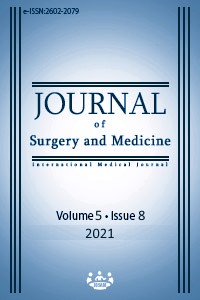Incidence and risk factors of nephrotoxicity associated with intravenous colistin use in the intensive care unit
Keywords:
Colistin, Nephrotoxicity, Intensive care unitAbstract
Background/Aim: The most serious side effect of colistin therapy is nephrotoxicity. This study aimed to investigate the incidence of nephrotoxicity (NT) due to intravenous colistin and determine the associated risk factors in critically ill patients in the intensive care unit (ICU). Methods: This retrospective cohort study was conducted by examining the files of 100 patients who were hospitalized in the ICU and received intravenous colistin therapy. According to the RIFLE criteria, the patients were divided into two groups as those with and without nephrotoxicity. The clinical characteristics of the patients were compared between the groups and the risk factors associated with nephrotoxicity were determined by multivariate linear logistic regression analysis. Results: The mean age, mean length of stay in the ICU, and mortality rate of 44 patients included in the study were 68±16.36 years, 77.14 (83.03) days, and 56.8%, respectively. NT developed in 22 (50%) patients during colistin therapy. In those with NT, diabetes mellitus, chronic obstructive pulmonary disease, and coronary artery disease were significantly more common (P<0.05 for all), the mean age (P<0.001), Charlson age-adjusted comorbidity index (CACI) scores, APACHE scores (P=0.010) were higher and albumin level was lower (P=0.001). High CACI scores (B=0.532, P=0.002) and low albumin levels (B=-0.323, P=0.023) were significant risk factors for colistin NT according to the regression analysis. Conclusion: Nephrotoxicity is significantly common among critically ill patients receiving colistin therapy. Patients with high CACI scores and hypoalbuminemia should be followed up closely for nephrotoxicity.
Downloads
References
Gunay E, Kaya S, Baysal B, Yuksel E, Arac E. Evaluation of prognosis and nephrotoxicity in patients treated with colistin in intensive care unit. Ren Fail. 2020;42:704–9.
Falagas ME, Fragoulis KN, Kasiakou SK, Sermaidis GJ, Michalopoulos A. Nephrotoxicity of intravenous colistin: A prospective evaluation. Int J Antimicrob Agents. 2005;26:504–7.
Kılınç Ç, Ulutaş KT, Akçimen B, Çelik L, Duran N. Colistin administration for extensive drug-resistant Pseudomonas aeruginosa pneumonia in intensive care unit: case report. Cukurova Med J. 2016;41:178.
Hartzell JD, Neff R, Ake J, Howard R, Olson S, Paolino K, et al. Nephrotoxicity associated with intravenous colistin (colistimethate sodium) treatment at a tertiary care medical center. Clin Infect Dis. 2009;48:1724–8.
Doshi NM, Mount KL, Murphy C V. Nephrotoxicity associated with intravenous colistin in critically ill patients. Pharmacotherapy 2011;31:1257–64.
Ordooei Javan A, Shokouhi S, Sahraei Z. A review on colistin nephrotoxicity. European Journal of Clinical Pharmacology. 2015;71:801-10.
Çiftçi A, Izdes S, Altintas ND. Factors determining nephrotoxicity and mortality in critical care patients receiving colistin. J Infect Dev Ctries. 2017;11:912–8.
Talib S, Sharif F, Manzoor S, Yaqub S, Kashif W. Charlson comorbidity index for prediction of outcome of acute kidney injury in critically ILL patients. Iran J Kidney Dis. 2017;11:115–23.
Kelesidis T, Falagas ME. The safety of polymyxin antibiotics. Expert Opin Drug Saf. 2015;14:1687–701.
Balkan II, Dogan M, Durdu B, Batirel A, Hakyemez IN, Cetin B, et al. Colistin nephrotoxicity increases with age. Scand J Infect Dis. 2014;46:678–85.
Korkmaz Ekren P, Töreyin ZN, Berk Takir H, Kalamanoğlu Balci M, Gaygisiz Ü, Gürsel G, et al. Evaluation of nephrotoxicity and prognosis in patients treated with colistin due to hospital-acquired pneumonia. Tuberk Toraks. 2017;65:271–81.
Shariatmaghani S, Shariatmaghani SS, Sedaghat A, Najafi MN, Moghaddam AB. Colistin-associated acute kidney injury in intensive care unit patients: Significance of other confounding factors. Int Res J Med Med Sci. 2019;7:91–8.
Arslan Zİ, Özbudak E, Türkyılmaz N, Cesur S, Alparslan V, Mirhanoğulları AF, et al. Evaluation of the Use of Colistin on Nephrotoxicity and Mortality in the Intensive Care Unit. Turkiye Klin J Anesthesiol Reanim. 2015;13:21–4.
Kim J, Lee KH, Yoo S, Pai H. Clinical characteristics and risk factors of colistin-induced nephrotoxicity. Int J Antimicrob Agents. 2009;34:434–8.
Coşkun B, Azap A, Yılmaz G, Ayhan M, Sarıcaoğlu EM. Assessment of colistin treatment in multidrug-resistant gram-negative bacterial infections. Klimik Derg. 2020;33:142–7.
Kaya M, Tunçel Yİ, Kuru RN, Menteş S, Ünver S, Çeken S, ve ark. Onkoloji Hastanesi Yoğun Bakım Ünitesinde Kolistin İlişkili Nefrotoksisitenin Retrospektif Değerlendirilmesi. Türk Yoğun Bakım Derneği Derg. 2014;12:51–6.
Pogue JM, Lee J, Marchaim D, Yee V, Zhao JJ, Chopra T, et al. Incidence of and risk factors for colistin-associated nephrotoxicity in a large academic health system. Clin Infect Dis. 2011;53:879–84.
DeRyke CA, Crawford AJ, Uddin N, Wallace MR. Colistin dosing and nephrotoxicity in a large community teaching hospital. Antimicrob Agents Chemother. 2010;54:4503–4505.
Giacobbe DR, di Masi A, Leboffe L, Del Bono V, Rossi M, Cappiello D, et al. Hypoalbuminemia as a predictor of acute kidney injury during colistin treatment. Sci Rep. 2018;8:1–11.
Özkarakaş H, Köse I, Zıncırcıoğlu Ç, Ersan S, Ersan G, Şenoğlu N, et al. Risk factors for colistin-associated nephrotoxicity and mortality in critically ill patients. Turkish J Med Sci. 2017;47:1165–72.
Ozdemir A, Sen A, Erdivanli B, Hatinoglu N. Evaluation of colistin-associated acute renal failure in intensive care unit. Ann Med Res. 2019;26:1.
Downloads
- 437 417
Published
Issue
Section
How to Cite
License
Copyright (c) 2021 Ökkeş Hakan Miniksar, Erol Toy
This work is licensed under a Creative Commons Attribution-NonCommercial-NoDerivatives 4.0 International License.
















